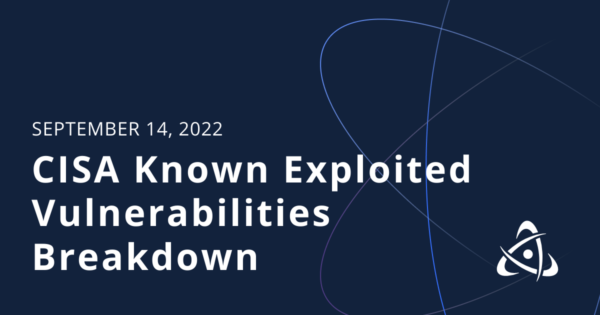CISA KEV Breakdown September 14, 2022

In this Breakdown, both vulnerabilities added to the catalog are 0-days discovered in household name services, Microsoft and Apple. First is CVE-2022-37969, a Microsoft CLFS privilege escalation vulnerability, and second is CVE-2022-32917, an Apple Kernel arbitrary code execution vulnerability. Luckily, both are known to be only executed with local access to the affected machine.
wpDataTable with provided ID not found!Notable Vulnerability Additions
CVE-2022-37969 | Microsoft Windows Common Log File System Privilege Escalation
With another patch Tuesday in the books, Microsoft addressed a total of 80 security issues, one of them being our 0-day, CVE-2022-37969. For successful exploitation, the attacker must already have access to the machine and the ability to run arbitrary code on the affected machine. In Microsoft’s update guide link down below, they address this vulnerability as being actively exploited.
It is unclear at this time if the 0-day discovered by ThreatLabz uses the same tactics and techniques deployed by attackers observed in the wild by Microsoft. The disclosure appears to be credited to four different security companies, DBAPPSecurity, Mandiant, Crowdstrike and ThreatLabz. This may indicate a wide range of observed exploit attempts.
Security Advisory:
https://msrc.microsoft.com/update-guide/en-US/vulnerability/CVE-2022-37969
CVE-2022-32917 | Apple Kernel Arbitrary Code Execution
From the Apple security advisory listing this CVE, “an application may be able to execute arbitrary code with kernel privileges. Apple is aware of a report that this issue may have been actively exploited.” This vulnerability appears to have been disclosed to Apple by an anonymous researcher, and there has yet to be any public-facing details related to the exploit or techniques involved. Users are encouraged to update to the latest versions of macOS Monterey 12.6 and iOS 15.7.
Security Advisory:
https://support.apple.com/en-us/HT213445, https://support.apple.com/en-us/HT213444
To get a better understanding of each component of our Breakdown, including what we determine to be a notable release, please see our Frequently Asked Questions section below. Also be sure to follow Nucleus Security on Twitter and LinkedIn where we will be posting each time a new Breakdown is released.
Frequently Asked Questions
- What makes for a notable addition?
- A notable addition can arise from many different characteristics. If a particular vulnerability is notable to the security community or a subset of the security community or if the EPSS score reveals notable information about the vulnerability, this can constitute further analysis. It may also be the case that a particular vulnerability shines a light on everyday users and we will highlight important information and key takeaways to ensure users and readers have easy access to actionable information.
- When is the Breakdown released?
- We aim to have our analysis of each KEV update posted within 24 hours of the time in which the Catalog is updated. See CISA’s full catalog here
- I am not bound by BOD 22-01 or federal regulations, why should the KEV concern me?
- CISA encourages all organizations to utilize the Catalog as an attribute in your vulnerability prioritization framework. Organizations looking to lessen the scope on known dangerous vulnerabilities and make a goal to remediate them can understand where they currently stand against what CISA has confirmed as exploited vulnerabilities in the wild. See CISA’s section on “How should organizations use the KEV catalog?” here.
- What is EPSS?
- EPSS is the Exploit Prediction Scoring System. It is an open, data-driven effort for estimating the likelihood (probability) that a software vulnerability will be exploited in the wild. See the EPSS home page on FIRST for more information here.
- What is the difference between EPSS probability and EPSS percent?
- EPSS probability is the risk calculated by the model when determining the perceived threat of the vulnerability itself. Percentage is a relative comparison of the rest of the CVEs within the given sample. While the probability only changes upon refreshing the results from the model, the percentage can change purely based on the CVE sample given. In the case of the Breakdown, we use the percentage given by the pool of all CVEs with given EPSS data. Scores may vary post-release of the post given new information about the vulnerabilities and their perceived threat. For more information on applying and understanding EPSS data, see this article on the FIRST website, as well as their FAQ page.
- What is GreyNoise?
- GreyNoise is a platform that collects, analyzes, and labels data on IPs that scan the internet and saturate security tools with noise. Through their sensor network, GreyNoise observes vulnerability exploitation attempts for vulnerabilities that are exploited in the wild over the Internet. These are arguably vulnerabilities that should be at the very top of your priority list to remediate.
- Why are GreyNoise exploitation attempts only observed on ~20% of KEV vulnerabilities?
- Exploitation of many vulnerabilities in the CISA KEV will not be observed for many reasons that GreyNoise does a good job of explaining in this post. For example:
- The vulnerability may not be remotely exploitable
- Vulnerability exploitation may require authentication (and result in privilege escalation)
- The impacted software may not be exposed to the internet
- Mass scanning/exploitation is not occurring yet
- Exploitation of many vulnerabilities in the CISA KEV will not be observed for many reasons that GreyNoise does a good job of explaining in this post. For example:
See Nucleus in Action
Discover how unified, risk-based automation can transform your vulnerability management.






























